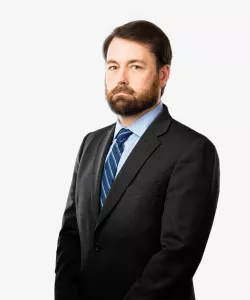Key Exclusions That Can Limit Your Insurance Coverage For COVID-19
In some of our previous Legal Alerts concerning insurance coverage for coronavirus related issues, we have highlighted some of the types of coverage that could apply to a COVID-19 related loss, such as business interruption, contingent business interruption, civil authority, and event cancellation. In this Legal Alert, we highlight three of the key exclusions that could serve to preclude or limit coverage for COVID-19: (1) the virus or bacteria exclusion; (2) the microorganism exclusion; and (3) the pollution exclusion.
It is always a two-step process for determining whether a party has insurance coverage for a loss. The first step is determining whether the coverage applies to the loss in question. This requires an analysis of the insuring agreement of the insuring policy, and in court, the burden is typically on the insured to prove that its loss triggers coverage under the insuring agreement of the policy. The second step is determining whether coverage is precluded or limited by an exclusion, and the insurer usually has the burden of proving that an exclusion clearly and unequivocally applies to bar coverage for a particular claim. Coverage for a COVID-19 loss is no different, as there may be certain exclusions that may be contained in a policy that can specifically preclude or limit coverage for a COVID-19 related loss.
The first type of exclusion that a policyholder may find in a general liability or property policy, especially one that provides business interruption coverage, is a virus or bacteria exclusion. The standard ISO form for this exclusion, added via endorsement, states, in relevant part, as follows:
We will not pay for loss or damage caused by or resulting from any virus, bacterium, or other microorganism that induces or is capable of inducing physical distress, illness, or disease. However, this exclusion does not apply to loss or damage caused by or resulting from “fungus,” wet rot, or dry rot.
This exclusion, to the extent included in policies, will likely continue to have a significant impact on business interruption coverage claims. It appears on its face to be clear that any claim for loss or damage caused by or resulting from any virus is excluded. In fact, there have been many reports around the country recently of policyholders having their business interruption or similar claims denied based upon this exclusion, or one very similar.
The second type of exclusion that a policyholder may find in its policy potentially impacting its business interruption coverage is commonly referred to as the “mold” exclusion, which is often included via endorsement, and states in pertinent part as follows:
This policy does not insure for loss, damage, claim, cost, expense or other sums directly or indirectly arising out of or relating to: Mold, mildew, fungus, spores or other microorganisms of any type, nature or description, including but not limited to any substance whose presence poses an actual or potential threat to human health. [Emphasis added]
The exclusion will also likely contain the following additional condition:
This exclusion applies regardless of whether or not there is: 1. Any physical loss or damage to insured property; 2. Any insured peril or cause, whether or not contributing concurrently or in any sequence; 3. Any loss of use, occupancy, or functionality to insured property; or 4. Any action required, including but not limited to repair, replacement, removal, cleanup, abatement, disposal, relocation, or steps taken to address medical or legal concerns.
While this exclusion purports to apply to loss of damages arising from “microorganisms of any type,” it is not clear whether a court may limit its application to mold and fungi microorganisms based on the preceding language in the exclusion. Typically, ambiguities are construed against the insurer and in favor of the insured.
The third type of exclusion that may be relied upon by an insurer in denying or attempting to limit coverage for a COVID-19 – related claim is the pollution exclusion in the policy. The standard ISO Commercial Property form includes the following exclusion in the Causes of Loss – Special Form (quoted in relevant part):
Discharge, dispersal, seepage, migration, release, or escape of “pollutants” unless the discharge, dispersal, seepage, migration, release, or escape is itself caused by any of the “specified causes of loss.” But if the discharge, dispersal, seepage, migration, release, or escape of “pollutants” results in a “specified cause of loss,” we will pay for the loss or damage caused by that “specified cause of loss.”
The term “pollutant” is defined in such policy form as:
Any solid, liquid, gaseous, or thermal irritant or contaminant, including smoke, vapor, soot, fumes, acids, alkalis, chemicals, and waste, regardless of whether or not such irritant or contaminant has any function in any insured’s or other’s business, operations, premises, site, or location. Waste includes materials to be recycled, reconditioned, or reclaimed.
In Motorists Mut. Ins. Co. v. Hardinger, 131 F. App’x 823 (3d Cir. 2005), for example, the Third Circuit Court of Appeals concluded that there was an issue of fact as to whether a claim under a homeowners policy arising from an E. coli infestation of a water well on the subject property, which caused viral infections to the inhabitants, made the property uninhabitable and, therefore, resulted in direct physical loss or damage under the insuring agreement of the policy. The Third Circuit also remanded to the district court the issue of whether the claim was excluded under the policy’s pollution exclusion, noting a split of authority on the issue:
Courts that have addressed whether bacteria fits under similar pollution exclusions are divided. Compare Keggi v. Northbrook Prop. and Cas. Ins. Co., 199 Ariz. 43, 47, 13 P.3d 785 (Ariz.App.Div.2000) (holding that bacteria does not constitute a pollutant under an identical pollution exclusion clause), and E. Mut. Ins. Co. v. Kleinke, Index # 2123–00, RJI # 0100062478 (N.Y.Super.Ct. Jan. 17, 2001) (holding that similar pollution exclusion is ambiguous on whether e-coli bacteria falls within the policy’s definition of pollutant), with Landshire Fast Foods of Milwaukee v. Employers Mut. Cas. Co., 269 Wis.2d 775, 676 N.W.2d 528, 532 (“bacteria, when it renders a product impaired or impure” falls within “the ordinary, unambiguous definition of ‘contaminant’ ”).
Hardinger, 131 F. App’x at 827.
As noted, there have already been many reports of policyholders having their business interruption coverage claims denied based on exclusions like one or more of those discussed above. While these types of exclusions may take the policyholder by surprise, it is important to note that any insurance policy containing these exclusions, like nearly every insurance policy, also contains a phrase on the first page of the policy similar to the following: “This is your insurance policy. Read it carefully.” As such, it will likely be difficult for a policyholder to argue that they were taken by surprise by the inclusion of these types of exclusion and/or by the potential impact these exclusions had on their coverage. The coverage analysis by the courts in litigation with respect to these exclusions will likely focus on whether the insurer has satisfied its burden to show that the exclusion clearly and unequivocally applies to the facts of the claim. Such an analysis will, under standard rules of insurance policy construction, strictly construe the terms of the exclusion in favor of the insured, and resolve any ambiguities in favor of the insured and coverage.
Any policyholder considering making a business interruption claim should have its policy reviewed by insurance professionals to determine if it contains one of the above-listed exclusions or an exclusion that similarly limits or excludes coverage. Depending on the type of exclusion in the policy, the insured may or may not have grounds to argue that coverage should apply under the circumstances.
Furthermore, when the policyholder’s policy is up for renewal, the policyholder may be able to negotiate the removal of certain exclusions (such as the virus or bacteria exclusion, which is typically added via endorsement and not a part of the main policy form), which may require the payment of additional premium. From the perspective of most insurers, the inclusion or removal of certain coverages and exclusions depends primarily on an assessment of the risk and the proper amount of premium to be charged. For the right price, insureds can often buy back covered for risks otherwise excluded under the insurer’s standard policy form.
Contacts
- Related Industries
- Related Practices



